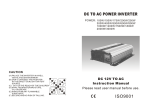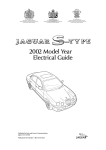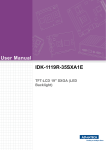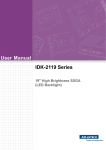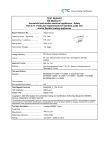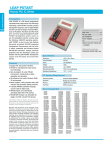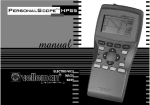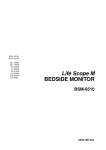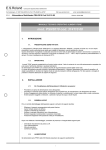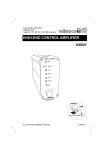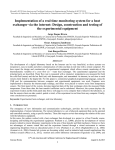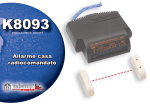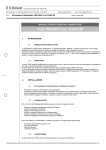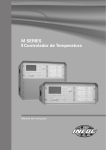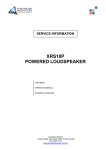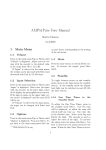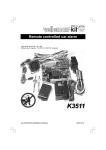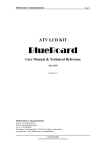Download HIGH-END MONO MOSFET POWER AMPLIFIER
Transcript
HIGH-END MONO MOSFET POWER AMPLIFIER Total solder points: 299 Difficulty level: beginner 1 2 3 4 5 ⌧ advanced K8040 ILLUSTRATED ASSEMBLY MANUAL H8040IP-2 Features & specifications Features : no compromise high-end design ideal to place next to the speaker (short wires to the speaker) auto-power on possibility when input signal is sensed auto-standby function when no input signal is sensed exclusive, high finish, solid aluminium enclosure high quality D-MOS IC output stage total of 40.000µF power supply capacitors relay-less speaker DC protection Real Clipping distortion indication power output level indication with backlight bypass output to drive bi-wired speakers using separate amplifiers double overheating protection with LED indication high grade speaker and input connections overload protection Specifications input: • input sensitivity for maximum output:............. 0dBm (= 0.775Vrms) • input impedance:................................................................ 15Kohm • minimum auto switch on voltage:....................................... 5mVrms output: • maximum RMS output power 4ohm:........................................ 90W • maximum RMS output power 8ohm:........................................ 70W • dynamic RMS output power in 4ohm: .................................... 125W • minimum load impedance: .................................................... 4 ohm • damping factor (ref. 8ohm 100Hz): ...................................... > 1000 audio: • signal-to-noise ratio (A-weighted ref. max. out): ................. >105dB • total harmonic distortion: ............................0.003% @ 1kHz ref 1W • frequency response:......................... 9Hz to 120kHz (-3dB) in 50W power requirements: • AC power: ....... 115Vac (110V to 120V) or 230Vac (220V to 240V) • consumption:................................................................. 100W max. dimensions: ..................................290 x 165 x 68mm (11.4" x 6.5" x 2.7") weight (net):........................................................................ 3.4kg (7.5Lbs) 3 Assembly hints 1. Assembly (Skipping this can lead to troubles ! ) Ok, so we have your attention. These hints will help you to make this project successful. Read them carefully. 1.1 Make sure you have the right tools: • A good quality soldering iron (25-40W) with a small tip. • Wipe it often on a wet sponge or cloth, to keep it clean; then apply solder to the tip, to give it a wet look. This is called ‘thinning’ and will protect the tip, and enables you to make good connections. When solder rolls off the tip, it needs cleaning. • Thin raisin-core solder. Do not use any flux or grease. • A diagonal cutter to trim excess wires. To avoid injury when cutting excess leads, hold the lead so they cannot fly towards the eyes. • Needle nose pliers, for bending leads, or to hold components in place. • Small blade and Phillips screwdrivers. A basic range is fine. For some projects, a basic multi-meter is required, or might be handy 0.0 00 1.2 Assembly Hints : ⇒ Make sure the skill level matches your experience, to avoid disappointments. ⇒ Follow the instructions carefully. Read and understand the entire step before you perform each operation. ⇒ Perform the assembly in the correct order as stated in this manual ⇒ Position all parts on the PCB (Printed Circuit Board) as shown on the drawings. ⇒ Values on the circuit diagram are subject to changes. ⇒ Values in this assembly guide are correct* ⇒ Use the check-boxes to mark your progress. ⇒ Please read the included information on safety and customer service 4 Assembly hints * Typographical inaccuracies excluded. Always look for possible last minute manual updates, indicated as ‘NOTE’ on a separate leaflet. 1.3 Soldering Hints : 1- Mount the component against the PCB surface and carefully solder the leads 2- Make sure the solder joints are cone-shaped and shiny 3- Trim excess leads as close as possible to the solder joint AXIAL COMPONENTS ARE TAPED IN THE CORRECT MOUNTING SEQUENCE ! REMOVE THEM FROM THE TAPE ONE AT A TIME ! 5 Construction CONSTRUCTION The unit consists of one main PCB with all the components including transformer and power supply. Tip: The pictures on the packaging can be used as a guideline. However, due to possible modifications they are not 100% reliable. Mount the components in the order described: 1. Jump wire 4. Resistors (check the color code) J1 J2 J3 J4 J5 J6 J7 J8 R... 2. Diodes (check the polarity) D ... CATHODE D1: 1N4148 D2: 1N4148 D3: 1N4148 D4: 1N4148 D5: 1N4148 D6: 1N4148 D7: 1N4148 D8: 1N4148 3. Zener diode (check the polarity) ZD... CATHODE ZD1: 20V / 1.3W (Mount 5mm above the PCB) 6 R1 R2 R3 R4 R5 R6 R7 R8 R9 R10 R11 R12 R13 R14 R15 R16 R17 R18 R19 R20 R21 R22 R23 R24 R25 R26 R27 : 1K : 1K : 15K : 1K : 470R : 100R : 15K : 15K : 15K : 15K : 470R : 15K : 15K : 100R : 15K : 2K2 0.6W : 100R : 1K : 470R : 2K2 0.6W : 1M : 470R : 1K : 470K : 470K : 470K : 100K (1 - 0 - 2) (1 - 0 - 2) (1 - 5 - 3) (1 - 0 - 2) (4 - 7 - 1) (1 - 0 - 1) (1 - 5 - 3) (1 - 5 - 3) (1 - 5 - 3) (1 - 5 - 3) (4 - 7 - 1) (1 - 5 - 3) (1 - 5 - 3) (1 - 0 - 1) (1 - 5 - 3) (2 - 2 - 2 - 9) (1 - 0 - 1) (1 - 0 - 2) (4 - 7 - 1) (2 - 2 - 2 - 9) (1 - 0 - 5) (4 - 7 - 1) (1 - 0 - 2) (4 - 7 - 4) (4 - 7 - 4) (4 - 7 - 4) (1 - 0 - 4) construction R28 : 2K2 0.6W R29 : 2K2 0.6W R30 : 0R R31 : 15K R32 : 100K R33 : 100R R34 : 0R R35 : 680R R36 : 15K R37 : 100K R38 : 470R R39 : 10R / 1W JGND: 0R (2 - 2 - 2 - 9) (2 - 2 - 2 - 9) (1 - 5 - 3) (1 - 0 - 4) (1 - 0 - 1) IC1 : 8p IC2 : 8p IC3 : 6p (6 - 8 - 1) (1 - 5 - 3) (1 - 0 - 4) (4 - 7 - 1) (1 - 0 - 0) 7. 10W resistor R... If long input signal wires are used a low input impedance can be useful. In this case mount for RX a 680R (6-8-1) resistor. Check if your pre-amplifier can drive low impedance! Our K8021 is OK for low impedance. Our K8020 is not suited for low impedance driving. Rx is normally left open. 5. Capacitors C1 C2 C3 C4 C5 C6 C7 C8 : : : : : : : : 100nF 100nF 100nF 100nF 100nF 100nF 100nF 100nF (104) (104) (104) (104) (104) (104) (104) (104) 6. IC sockets. Watch the position of the notch! c... 5mm R40 : 4R7 (4.7, 4R7) 8. Capacitors C9 C10 C11 C12 C13 C14 C15 C16 : : : : : : : : 2n2 (222) 220n (224) 1uF 1uF 2.2uF 2.2uF 100n / 250V 100n / 250V (104) (104) 9. Transistors T1: BC547 T2: BC547 7 Construction 10. RCA connectors. Mount them straight and against the PCB 12. Terminal blocks SK3: 3p "Mains in" SK4: 3p "Mains transformer" SK1: MJ-523AG/R SK2: MJ-523AG/B Tip: A red and a black type are delivered with the kit, if you bought 2 amplifiers for stereo then one amplifier can be built with red connectors (right amp.) and one with the black connectors. 11. Push button. Mount them straight against the PCB surface ! SK5+SK6: 2x 2 pole Transformer output First slide these two connectors in each other. 13. Terminal connectors SW1: TS-04PV Check that the position corresponds with the PCB silk printing. SK7: 2 pole Temp sensor SK8: 2 pole Power meter SW2: KRS1243 8 SK9: LS+ SK10: LS- construction 14. Coil 16. Voltage regulator. The back side corresponds to the thick line. L... VR1 UA7805 VR... This coil will have to be made by yourself. Use the supplied copper wire (1.5mm) with the kit. Wind this wire round a 8mm drill or other round object and make 8 turns. 17. Triac. The back side corresponds to the thick line. You can snip off the remaining copper TR1: TIC246 or eq. Then remove (scratch) the isolation from the connections using a knife. TR... Mount the coil and make sure to have a perfect soldering. L1: 8 Turns dia 8mm 18. Bridge rectifier. Check the polarity !! 15. Electrolytic capacitors. Check the polarity ! C17: 10µF C18: 10µF C19: 10µF C20: 10µF C21: 10µF C23: 1µF C24: 10µF C25: 47µF/63V C26: 47µF/63V C27: 47µF/63V C28: 47µF/63V C29: 220µF/63V C30: 220µF/63V BR1: RS603 C... 19. LEDs COLOR= 2...5 LD... CATHODE LD1: LED3RL (3mm LED) LD2: LED3RL (3mm LED) LD3: LED3RL (3mm LED) 9 Construction 20. Power electrolytic capacitors. Check the polarity ! C31: 10.000µF C32: 10.000µF C33: 10.000µF C34: 10.000µF 21. IC’s. Watch the position of the notch ! C... IC1: VK8040 (PIC12C508) IC2: CA258 or eq. IC3: MOC3041 / KP3020 22. Mounting front LED’s. Check the polarity ! Short lead = Cathode or - ! CAUTION: After bending the leads the long appearing lead will be the cathode! LD ... C ATH O DE IMPORTANT Mount these LED’s exactly like in the drawing, otherwise some LED’s will Next: Solder one lead, and check the not fit correctly in the front panel. Please also use the front panel as a position, if necessary correct by positioning reference. heating the soldering. First: Bend the leads exactly like the drawing. Last: Solder the second connection. LD4: L-424YDT LD5: L-424YDT LD6: L-424YDT LD7: L-424YDT 12m m C 7mm Meter backlight: LD8 is a white LED serving as backlight for the power meter. LD8: L5WD (5mm white) LD... CATHODE 3mm 10 18mm construction 23. Mounting the Power IC IC4: TDA7293 Mount the support plate onto the IC as shown in the drawing. Put a drop of silicone compound on both sides of the mica isolator. Also check the position of the plastic isolator A. ATTENTION : The bolt should be inserted on the side of the IC holder with the countersunk opening B ! B A A Drop of heat conductive compound DO NOT TIGHTEN THE NUT YET 1. 2. 3. 4. 5. Position the IC onto the PCB. Make sure that the support plate is touching the PCB surface. Tighten the support nut. Check again that the plate is touching the PCB surface. Solder the IC connections. 11 Construction 24. Mounting the power transformer and mains voltage selection Mount the transformer as in the drawing (see also the picture on the packaging) Use the supplied straps (4 pcs) to fix the transformer. Primary windings (MAINS) connection: Check the table on the PCB for the correct voltage selection and connect the wires : For 230V (220V to 240V), edge orange, then brown and black. For 115V (110V to 120V), edge brown, then orange and black. Using a black marker, erase the not used voltage on the rear panel of the unit! 230V 120V ORANGE BROWN BROWN ORANGE BLACK BLACK Secondary windings connection: Connect the Red, Yellow, Blue and Grey wire to the SK5/SK6 connector, check the colors on the PCB. 12 Enclosure preparation 25. Enclosure preparation Cut the thread in the holes for the enclosure feet in one of the aluminum profiles, using the supplied special M4 screw as a tap. FIG. 1 Mount the feet on the aluminum profile, using two M4 hexagonal Allen screws. Use the supplied Allen wrench. It is advisable to stick the protection adhesive onto the feet. FIG. 2 Cut the thread in the front and back of the aluminum profiles, using the supplied special M4 screw (4 holes per piece) FIG. 3 13 Enclosure preparation Position the main PCB in the aluminum profile that is prepared with the feet. Mark the center position of the three fixation holes on the aluminum. A reference indication is also on the PCB edge. FIG. 4 Remove the pcb and use a knife or a screwdriver to scratch the paint from the aluminum fixation, from the hole closest to the back end. This fixation will be used later to connect the ground and earth. FIG. 5 Mount the three 5mm (0.14”) spacers as shown in the drawing. Use three hexagonal screws and 3 washer. Do not tighten the spacers yet. FIG. 6 5mm M3 spacer M3 hex. nut Washer Position the PCB in the enclosure and check if the position of the spacers is correct, if so, remove the PCB and tighten the spacers. 14 Enclosure preparation Using an ohmmeter, measure between the edge of the aluminum profile and the back spacer, if there is a good electric contact (less then 10 ohm). If not, repeat the above step to remove the paint under the spacer. 0.0 00 FIG. 7 Slide two M3 nuts and two hexagonal bolts into the profile, the nuts will be used for the temperature sensor, the bolts will be used for the IC support plate: FIG. 8 Mount the temperature sensor, check the exact position. Make sure there is silicone compound between the sensor and the enclosure! Solder the wires of the supplied two pole connector onto the sensor. There is no polarity. 11 cm FIG. 9 15 Final assembly 26. final PCB mount RE-CHECK CAREFULLY THE PCB FOR MOUNTING AND SOLDERING ERRORS! Mount the pcb into the enclosure, check the position of the power IC. The IC support must fit onto the previously inserted hexagonal bolts. Make sure there is silicone compound between the IC support and the enclosure! Glue the included insert C between the transformer and housing. C Make sure the PCB is aligned with the back of the enclosure IMPORTANT: FIRST fix the IC support THEN fix the pcb using three 5mm spacers + washer. DO NOT TIGHTEN THESE FIXATIONS YET. Note: Not all components are visible on the drawing. 16 Final assembly 27. Speaker and mains connector assembly Prepare the wiring of the mains connector like in the drawing. First mount the switch into the mains connector assembly. Do not forget to isolate the soldering connections using a piece of shrink tube. Use the supplied 0.5mm wire: Blue for Neutral Brown for Live Yellow/green for earth Use 3 pieces of about 10cm for later connection to the PCB mains connector. Brown Blue Yellow/green Mount the speaker connectors onto the rear panel. (black = negative) Take care of the isolation washers, there are two different types! See picture. Make sure the connectors are very tight fit, and do not make electrical contact with the panel (check using ohm meter!). Isolation washer ! 17 Final assembly 28. Final assembly and connection Solder a 15cm (2.5mm) wire to the LS connectors. Black = negative, Red= positive, use a shrink tube to isolate the connection. Solder a spade terminal to the other end, do not forget the terminal isolation. 15cm Mount (insert) the mains connector onto the rear panel. Insert a 2A fuse into the connector (there is also room for a spare fuse). 18 Final assembly Mount the rear panel onto the enclosure, using two M4 Allen screws. Connect the speaker wires to the speaker output tabs. Check the polatity! Black= LS-, Red= LS+. ! DO NOT CONNECT THE MAINS WIRING WITH THE PCB YET! 29. Preparing the front panel Connect the two wired connector to the meter, RED = +, BROWN = - to the meter. Mount the power meter onto the front panel. Fix the meter using a piece of transparent adhesive tape (four sides). Make sure the meter is positioned straight. Connect the meter to the PCB (SK8) Mount the front panel onto the front, using two M4 Allen screws. Check the position of the LED’s and check if the button is working correctly. It could be that paint covering the holes, is preventing the buttons from smooth operation. Now the three PCB fixations can be tightened. Check the push button. 19 Test 30. Test 21. Mains voltage connection ! preparation Check again all connections of transformer and mains Connect the mains wires to the mains connector SK3, Blue= Neutral, green/ yellow= Earth. Connect a 60W light bulb in series with the Live (Brown wire) and the Live Connect a 10cm blue wire to the connection on the PCB. point of SK12. Mount both the fuse and the spare fuse in theNfuse holder. Connect a 10cm brown wire to the point L of SK12. Connect a 10cm yellow/green wire to the earth point of SK12. Later these connection will be soldered to the mains connector. ! CAUTION: Some points on the PCB are connected to the dangerous mains voltage. Connect the mains AC voltage to the mains. See also the user manual about the power cord. Normally after switching ON the amplifier, the light bulb should briefly light up. If the bulb glows constantly, disconnect the power immediately and recheck all connections. • Normally the standby LED on the front panel should light as should both 35V power indication LED’s LD2 and LD3. 20 Test Test continued: • Now push the DC protection test button SW2, the bulb should light if the button is pressed. Be careful not to touch any exposed live parts. • Disconnect the mains plug. • Now the brown Live wire can be connected directly to the connector SK3. Check the user manual to test all functions and operation of the unit. Finally the cover can be mounted. Please note that the user manual is also used for the assembled version, some remarks may not apply to the kit version. 21 22 1 Vdd Vss GP4/OSC2 8 470K 1M 4 10µ C24 R21 Auto on LM258 R27 100K 1N4148 STBY / ON SW1 C21 10µ R14 100R R15 15K Stby / ON R10 15K CLIP LED BC547 T2 R5 470R LD7 R28 2K2 / 0.6W LD2 +35V Power supply indication R11 470R LD1 +5V CLIP +5V 47µ/63V C28 LED3RL 5mV input signal detector for AUTO ON 470K 1K 5 D8 R2 1K 2u2 C14 R35 680R LED3RL R23 8 LM258 IC2A 7 R6 100R ON L-424YDT LD5 10µ STBY R34 THERMAL SHUTDOWN 2K2 / 0.6W R29 100n C7 LED3RL LD3 0R C25 47µ/63V 1 IC2B +5V LD8 HFWA05 R8 15K +5V +5V 9 STBY MUTE BUFFER DRIVER +35V STBY-GND 6 Temp error T1 BC547 10µ C19 MUTE SGND C26 R30 47µ/63V 0R 8 1 R24 470K L-424YDT 15K LD6 R4 1K Temp sens. 2 1 SK7 15K R12 10 4 3 IN+ C6 C18 10µ O 100n C2 IC4 R36 15K R38 470R 1N4148 D7 Clip detect TDA7293V CLIP DET 5 BOOTSTRAP 6 12 OUT 14 BOOT LOADER R20 DC prot. test2K2 / 0.6W +35V 10µ C17 +5V K8040 INTEGRATED MONO MOSFET AMPLIFIER 1uF C11 -35V S/C PROTECTION C12 1uF SW2 I VR1 UA7805 2K2 / 0.6W SW KRS1243 R16 -VS 2 3 C5 100n R3 15K R7 +5V C20 R31 15K 2 IN- 100n -35V 20V 1.3W 15 D2 1N4148 D1 1N4148 CLIP LED Auto on Stby / ON Clip detect C9 2n2 backlight +5V GP5/OSC1/CLKIN 2 3 4 5 15K R13 100R 220µ/63V C30 220µ/63V C29 C31 10.000uF/50V 0R JGND +35V ZD1 -PWVs R26 GP2/T0CKl OFF / Stby 2u2 R33 1N4148 1N4148 1N4148 1N4148 10.000uF/50V C32 C33 C34 +VS R25 7 GP1 6 GP0 R1 1K L-424YDT C13 D6 D5 D4 D3 + 10.000uF/50V 10.000uF/50V +PWVs GP3/MCLR/Vpp PIC12C508A IC1 C1 100n 4 LD4 6 +5V 2 +5V IC3 K3020P C4 - BRIDGE RS603 AC2 C8 100n RX Rload 1 DC Protection (fuse blow) R19 470R 100n 100n C3 BR1 7 BYPASS R18 1K SK6 SK5 11 SK2 100NF/250VAC C16 25VAC / 2A 25VAC / 2A 13 R32 100K INPUT C15 R17 100R TR1 SK4 Transfo Prim AC1 100NF/250VAC 470R R22 4.7R / 10W TIC246M GND SK1 SK3 R40 Mains in from 2A fuse + switch 2 1 SK8 Power meter 1.0 R9 15K +5V 47µ/63V C27 L1 220nF C10 10R/1W R39 LS- SK10 LS+ SK9 8T 1.5mm dia 8mm C23 1µ 100K R37 Schematic diagram 31. Schematic diagram L-424YDT PCB 32. PCB 23 VELLEMAN KIT NV Legen Heirweg 33 9890 Gavere Belgium Europe Info ?: http://www.velleman.be Modifications and typographical errors reserved © Velleman Kit nv H8040IP - 2009 - ED2 5 410329 416775

























